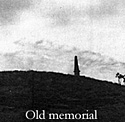
There are three major changes to the Talavera battlefield. The first is the town itself which has expanded greatly, secondly the new motorway that bisects the battlefield on an east-west axis and thirdly, a dam has been constructed and an area flooded to the north of the Medellin and Cascajal hills.
Near the town is a confusing scatter of smallholdings, restaurants and other buildings that eventually reach the motorway. Finding any of the points of interest in this jumble requires a very good modern map, as well as an historical map of the battle. A compass, divining rod and plenty of pa- tience would also help. Or you can do as I did and go with a competent guide. The motorway is, of cause, hard to miss but is, I feel, south of the position shown in Julian Paget's book 'Wellingtons Peninsular War'.
 The modern memorial built just to the north of the motorway on the southern slopes of the Medellin is an interesting addition to the battlefield. Artistic aesthetics aside, it does give a good view of the southern half of the battle area. There is also a plan showing the contending armies' positions made from tiles that I would love on my bathroom wall.
The modern memorial built just to the north of the motorway on the southern slopes of the Medellin is an interesting addition to the battlefield. Artistic aesthetics aside, it does give a good view of the southern half of the battle area. There is also a plan showing the contending armies' positions made from tiles that I would love on my bathroom wall.
 To the north of the memorial you have a good view of the Medellin and a new villa that has been built just about where Wellesley had his viewpoint. There was an old memorial here but it has been shunted to the lonely back slopes of the Medellin. Once up on the
Medellin the best views are on the knoll east of the
villa, just in front of a water pumping station. If you
look east the first thing you nouce is the dam on you
left, behind which is the reservoir which covers the
area where the 23rd came to grief. The Cascajal
slopes down to the Portina Brook in what appears to
be a gentle slope; it was down this slope that the
French night attack and the first attacks on the 28th
came.
To the north of the memorial you have a good view of the Medellin and a new villa that has been built just about where Wellesley had his viewpoint. There was an old memorial here but it has been shunted to the lonely back slopes of the Medellin. Once up on the
Medellin the best views are on the knoll east of the
villa, just in front of a water pumping station. If you
look east the first thing you nouce is the dam on you
left, behind which is the reservoir which covers the
area where the 23rd came to grief. The Cascajal
slopes down to the Portina Brook in what appears to
be a gentle slope; it was down this slope that the
French night attack and the first attacks on the 28th
came.
Away to your right, on the other side of the motorway, is the area of the big French attack against the 1st Division. For me the most interesting view is down from the Medellin into the Portina Brook. I had a suspicion that it was steeper than it looked so I walked down the slope and stood by the brook. Today it is overgrown and would be a considerable obstacle for a soldier with a machete. Turning round I looked back up the Medellin and my respect grew for the French soldiers who, weighed down with muskets and packs, struggled over the brook, then climbed the hill in the face of British skirmishers and tried to keep their formation. The slope up the Medellin is steep and covered with rocks and scrub; I climbed carrying a camera and was sweating and puffing by the time I reached the top. They must have made them tough in those days or maybe we are a lot softer. Talavera is the first Peninsular War battlefield I have visited and it was well worth it. I have studied maps and photographs, but nothing comes close to giving you the appreciation of the battlefield that you get when you walk over it. If you get the opportunity go yourself as it makes all the reading of Napier, Oman and Weller come alive, not to mention Sharpe.
Part 12: List of Forces (Order of Battle)
Back to Table of Contents -- First Empire 26
© Copyright 1996 by First Empire.
This article appears in MagWeb (Magazine Web) on the Internet World Wide Web.
Other military history articles and gaming articles are available at http://www.magweb.com